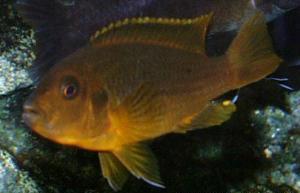Cichlid - Rusty
Scientific Name: Iodotropheus sprengerae
Fri, 11th April, 2025 - 11:12 pm GMT
Sponsor Ads:

Alternative Name
Scientific Name: Iodotropheus sprengeraeBasic Info
The Rusty Cichlid ranges in color from shades of deep brown-orange to lighter orange red. At maturity, they are normally three to four inches (seven and a half to ten centimeters) long. Often, the development of their color and the encouragement of their growth are achieved by feeding these fish specific dietary items.
Health
Rusty Cichlids usually do well in brighter full spectrum lighting. Enclosure temperatures are usually kept between 73 and 82 degrees Fahrenheit (23 to 28 degrees Celsius). Water should have a pH level between 7.6 and 8.6. The GH level should remain at 7 and the KH level should be between 10 and 12. Enclosures should allow rocks, pieces of clay flowerpots, and driftwood in order to allow Rusty Cichlids to hide and create territories. Although live plants are nice, Rusty Cichlids have a tendency to eat them. Tough plants such as Java Moss and Java Fern are recommended. Water should be changed often. Rusty Cichlids should be fed frozen or live bloodworms, glass worms, and brine shrimp may be offered along with frozen daphnia, beef heart, or plankton. Live fish and tubifex worms can also be fed. It is believed by many that feeding Cyclops will enhance the color of these fish. The protein portion of the Rusty Cichlid's diet should be supplemented with spinach, lettuce, zucchini, and peas. Although many Rusty Cichlids do well on freeze dried or tablet food, a more natural diet is preferred. Breeding Normally, Rusty Cichlids can be sexed by the appearance of their anal fins. Usually males have well defined egg spots and longer anal fins. It is normal for Rusty Cichlids to produce 5 to 60 eggs, which are spawned inside the female's mouth. There should be plenty of plants or rocky surfaces in the enclosure where fry are kept to ensure that sufficient surface area for them to feed from is available. They usually pick tiny organisms off of plants or rocky crevices.Habitat
Fresh water fishBehavior
The lovely Rusty Cichlid is a peaceful, Mbuna type Cichlid that can make an impressive addition to many aquariums. These fish are highly prized by their owners for their temperaments and their beautiful coloring. Rusty Cichlids usually get along fairly well with other fish in their enclosures. They do not remain in a specific area of their habitats; rather, they range through top, middle, and bottom levels of their tanks. They may demonstrate schooling behavior and, though territorial, are not overly aggressive. Rusty Cichlids should not be kept with aggressive fish, or they could be bullied.Origin
Origin or Range:History
Rusty Cichlids are native to eastern Africa, particularly to Lake Malawi. Although many people adore Rusty Cichlids, in past years owners have complained that these fish did not have coloring as intense as they would have liked. Many people have remedied this problem by providing more natural, brighter lighting for these fish in addition to feeding them more natural diets.Common Foods
N/ASponsor Ads:
The great classes of people will more easily fall victims to a great lie than to a small one. -- Unknown
Cichlid - Rusty
Coded by: BGID® | ALL RIGHTS RESERVED Copyright © 2000-2025
Disclaimer | Privacy | Report Errors / Contact | Credits










